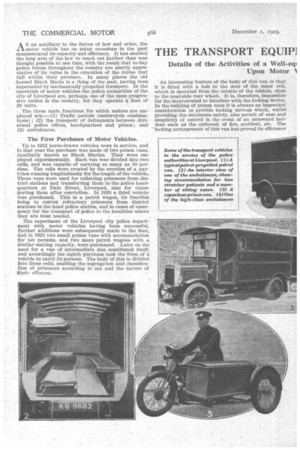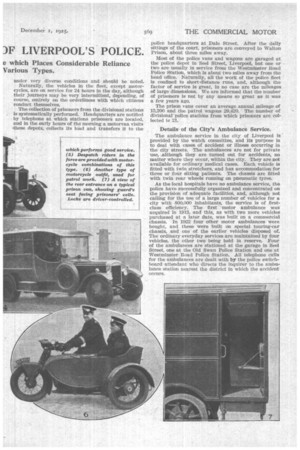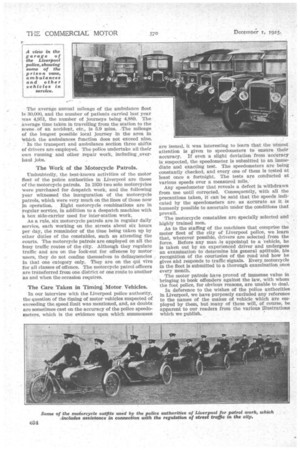THE TRANSPORT EQUIP] )F LIVERPOOL'S POLICE.
Page 16

Page 17

Page 18

If you've noticed an error in this article please click here to report it so we can fix it.
Details of the Activities of a Well-eqi Upon Motor e which Places Considerable Reliance Various Types.
As a auxiliary to the forces of law and order, the
n motor vehicle has on many occasions in the past demonstrated its capacity and efficiency, It has enabled the long arm of the law to reach out farther than was thought possible at one time, with the result that to-day police forces throughout the country are alertly appreciative of its value in the execution of the duties that fall within their province. In many places the old horsed Black Maria is a thing of the past, having been Superseded by mechanically propelled transport. In the operation of motor vehicles the police authorities of the city of Liverpool are, perhaps, one of the most progressive bodies in the country, for they operate a fleet of 26 units.
• The three main functions for which motors are employed are :—(1) Traffic patrols (motorcycle combinations) ; (2) the transport of delinquents between divisional police offices, headquarters and prison ; and (3) ambulances.
The First Purchases of Motor Vehicles.
Up to 1912 horse-drawn vehicles were in service, and in that year the purchase was made of two prison vans, familiarly known as Black Marias. They were employed experimentally. Each van was divided into two cells, and was capable of carrying as many as 50 perElons. The cells were created by the erection of a partition running longitudinally for the length of the vehicle. These vans were used for collecting prisoners from district stations and transferring them to the police headquarters at Dale Street, Liverpool, also for transPorting them after conviction. In 1920 a third vehicle Was purchased. This is a patrol wagon, its function being to convey refractory prisoners from district stations to the head police station, and in cases of emergency for the transport of police to the localities where they are most needed.
The experiment of the Liverpool city police department with motor vehicles having been successful, further additions were subsequently made to the fleet, And in 1920 two small prison vans with accommodation for ten persons, and two more patrol wagons with a similar seating capacity, were purchased. Later on the need for a van of intermediate size manifested itself, and accordingly the eighth purchase took the form of a Vehicle to carry 24 persons. The body of this is divided Into three cells, enabling the segregation and classification of prisoners according to sex and the nature of OW offences. An interesting feature of the body of this van is that It is fitted with a bolt to the door of the inner cell, which is operated from the outside of the vehicle, close to the near-side rear wheel. It is, therefore, impossible for the incarcerated to interfere with the locking device. In the building of prison vans it is always an important consideration to provide locking devices which, whilst providing the maximum safety, also permit of ease and simplicity of control in the event of an untoward incident such as the outbreak of fire, accident, etc. The locking arrangement of this van has proved its efficiency
under very diverse conditions and should be noted.
Naturally, the vehicles in the fleet, except motorcycles, are on service for 24 hours in the day, although their journeys may be very intermittent, depending, of course, entirely on the orderliness with which citizens conduct themselves.
The collection of prisoners from the divisional stations is systematically performed. Headquarters are notified by telephone at which stations prisoners are located, and in the early hours of the morning a motorvan visits 'these depots, collects its load and transfers it to the police headquarters at Dale Street. After the daily sittings of the court, prisoners are conveyed to Walton Prison, about three miles away.
Most of the police vans and wagons are garaged at the police depot in Seel Street, Liverpool, but one or two are usually in service from the Westminster Road Police Station, which is about two miles away from the head office. Naturally, all the work of the police fleet is confined to short-distance runs, and, although the factor of service is great, in no case are the mileages of large dimensions. We are informed that the number of prisoners is not by any means so great as it was a few years ago, The prison vans cover an average annual mileage of 15,200 and the patrol wagons 29,420. The number of divisional police static:ins from which prisoners are collected is 21.
Details of the City's Ambulance Service.
The ambulance service in the city of Liverpool is provided by the watch committee, and its purpose is to deal with cases of accident or illness occurring in the city streets. The ambulances are not for private use, although they are turned out for accidents, no matter where they occur, within the city. They are not available for ordinary medical cases. Each vehicle is fitted with twin stretchers, and has accommodation for three or four sitting patients. The chassis are fitted with twin rear wheels running on pneumatic tyres.
As the local hospitals have no ambulance service, the police have successfully organized and concentrated on the provision of adequate facilities, and, although not calling for the use of a large number of vehicles for a city with 800,000 inhabitants, the service is of firstclass efficiency. The first motor ambulance was acquired in 1913, and this, as with two more vehicles purchased at a later date, was built on a commercial chassis. In 1922 four other motor ambulances were bought, and these were built on special touring-car chassis, and one of the earlier vehicles disposed of. The ordinary everyday services are maintained by four vehicles, the other two being held in reserve. Four of the ambulances are stationed at the garage in Seel Street, one at the Old Swan Police Station and one at Westminster Road Police Station. All telephone calls for the ambulances are dealt with by the police switchboard attendant who directs the inquirer to the ambulance station nearest the district in which the accident The average annual mileage of the ambulance fleet Is 30,000, and the number of patients carried last year was 4,951, the number of journeys being 4,889. The average time taken in travelling from the station to the scene . of an accident, etc., is 5.9 mins. -The mileage of the longest possible local journey in the area in `which the ambulances function does not exceed nine.
In the transport and ambulance section three shifts of drivers are employed. The police undertake all their own running and other repair work, including overhaul jobs.
The Work of the Motorcycle Patrols.
Undoubtedly, the best-known activities of the motor fleet of the police authorities in Liverpool are those of the motorcycle patrols. In 1920 two solo motorcycles were purchased for despatch work, and the following year witnessed the inauguration of the motorcycle patrols, which were very much on the lines of those now operation. Eight motorcycle combinations are in regular service, in addition to a despatch machine with it box side-carrier used for inter-station work.
As a rule, six motorcycle patrols are in regular daily service, each working on the streets about six hours per day, the remainder of the time being taken up by other &ties of the constables, such as attending the courts. The motorcycle patrols are employed on all the busy traffic routes of the city. Although they regulate traffic and are on the look-out for offences by motor users, they do not confine themselves to delinquencies In that one category only. They are on the qui vive for all classes of offence. The motorcycle patrol officers are transferred from one district or one route to another as and when the occasion requires.
The Care Taken in Timing Motor Vehicles.
In our interview with the Liverpool police authority, the question of the timing of motor vehicles suspected of exceeding the speed limit was mentioned, and, as doubts are sometimes cast on the accuracy of the police speedometers, which is the evidence upon which summonses are issued, it was interesting to learn that the utmost attention is given to speedometers to ensure their accuracy. If even a slight deviation from accuracy is suspected, the speedometer is submitted to an immediate and exacting test. The speedometers are being constantly checked, and every one of them is tested at least once a fortnight. The tests are conducted at various speeds over a measured mile.
Any speedometer that reveals a defect is withdrawn from use until corrected. Consequently, with all the precautions taken, it can be said that the speeds indicated by the speedometers are as accurate as it is humanly possible to ascertain under the conditions that prevail.
The motorcycle constables are specially selected and highly trained men.
As to the staffing of the machines that comprise the motor fleet of the city of Liverpool police, we learn that, wherever possible, drivers are selected from the force. Before any man is appointed to a vehicle, he is taken out by an experienced driver and undergoes an examination to determine his general aptitude, his recognition of the courtesies of the road and how he gives and responds to traffic signals. Every motorcycle in the fleet is submitted to a thorough examination once every month.
The motor patrols have proved of immense value in bringing to book offenders against the law, with whom the foot police, for obvious reasons, are unable to deal.
In deference to the wishes of the police authorities in Liverpool, we have purposely excluded any reference to the names of the makes of vehicle which are employed by them, but many of these will, of course, be apparent to our readers from the various illustrations which we publish.






























